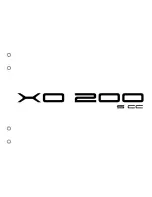
Rules of
The nautical traffic rules for preventing collisions
the Road
on the water.
Scope
The length of the anchor rope or chain. 6 to 1 scope means
that the length of the anchor rope from the boat to the anchor
is 6 times the depth of the water.
Scupper
A hole allowing water to run off the deck.
Sea Anchor
A floating canvas cone held open by wire rings with an open-
ing in the smaller end and a rope bridle at the larger end
attached to a line leading to the vessel; used in storm condi-
tions to
(a) keep the bow of the boat to the wind, and
(b) slow downwind drift of the boat.
Seacock
A thru-hull valve; a shutoff on a plumbing or drain pipe
between the vessel’s interior and the sea.
Slip
(1) A berth for a boat between two piers or floats;
(2) The percentage difference between the theoretical and the
actual distance that a propeller advances when turning in
water under load.
Sole
The cabin or cockpit floor.
Spar Buoy
A channel marker that looks like a tall, slender pole.
Stand-On
The vessel with the right-of-way.
Vessel
Starboard
The right side of a boat when you are facing the bow.
Stern
The after end or back of the boat.
Stow
To store items neatly and securely.
Strake
Planks running fore and aft on the outside of a vessel.
Taffrail
The rail around a boat’s stern.
Tide
The alternate rise and fall of waters caused by the
gravitational attraction of moon or sun.
Topsides
(1) The sides of a vessel above the waterline;
(2) On deck as opposed to below deck.
Transom
The transverse planking which forms the after end of a small,
square-ended boat. (Outboard motors are usually attached to
a transom.)
Trim
To arrange weights in a vessel in such a manner as to obtain
desired draft at bow and stern.
Unbend
To cast off or untie.
12.7
B
O
A
T
IN
G
T
E
R
M
S
Lund-12.indd 7
7/9/10 1:57 PM
https://www.boat-manuals.com/



































